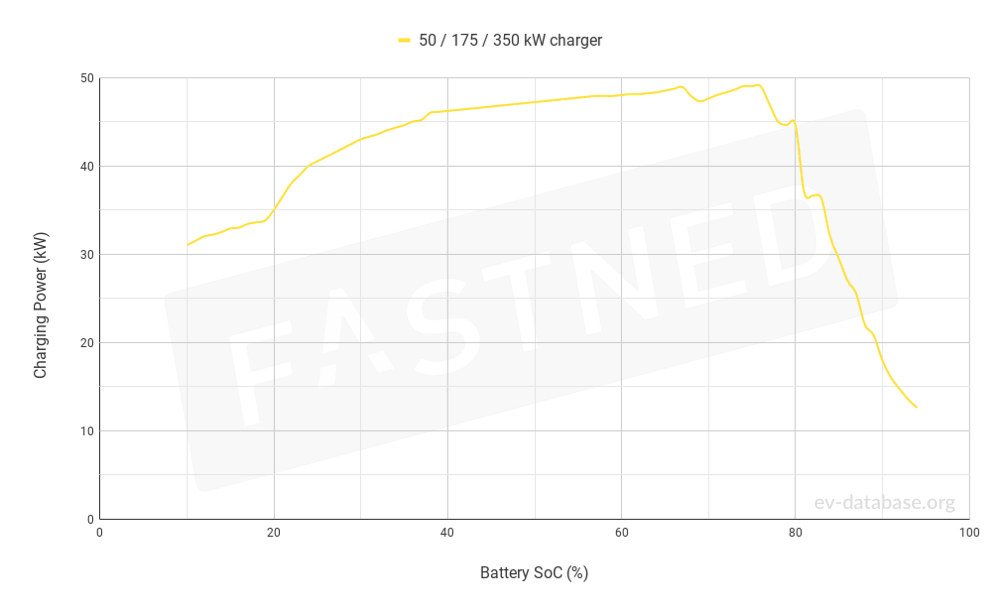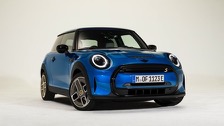Price from (last known)
£25,100
| Availability |
Not available to order |
| Available to order from |
March 2020 |
| Available to order until |
March 2021 |
| Annual VED |
£0 |
| Congestion Charge |
£11.50 |
| Insurance Group |
22-23 |
Price shown is the last known On The Road price: it includes VAT, first year VED, vehicle first registration fee, number plates and delivery.
The price also includes the applicable Plug-In Car Grant of £3000 at the time the vehicle was last available.
Real Range between 80 - 170 mi
| City - Cold Weather |
110 mi |
| Highway - Cold Weather |
80 mi |
| Combined - Cold Weather |
95 mi |
| City - Mild Weather |
170 mi |
| Highway - Mild Weather |
100 mi |
| Combined - Mild Weather |
130 mi |
Indication of real-world range in several situations. Cold weather: 'worst-case' based on -10°C and use of heating. Mild weather: 'best-case' based on 23°C and no use of A/C. For 'Highway' figures a constant speed of 70 mph is assumed. The actual range will depend on speed, style of driving, weather and route conditions.
Battery
| Nominal Capacity |
32.6 kWh |
| Battery Type |
Lithium-ion |
| Number of Cells |
No Data |
| Architecture |
400 V |
| Warranty Period |
8 years |
| Warranty Mileage |
100,000 mi |
| Useable Capacity |
28.9 kWh |
| Cathode Material |
No Data |
| Pack Configuration |
No Data |
| Nominal Voltage |
No Data |
| Form Factor |
No Data |
| Name / Reference |
No Data |
Charging
Home / Destination
| Charge Port |
Type 2 |
| Port Location |
Right Side - Rear |
| Charge Power † |
11 kW AC |
| Charge Time (0->110 mi) † |
3h15m |
| Charge Speed † |
36 mph |
Rapid Charging
| Fastcharge Port |
CCS |
| FC Port Location |
Right Side - Rear |
| Fastcharge Power (max) |
49 kW DC |
| Fastcharge Power (10-80%) |
44 kW DC |
| Fastcharge Time (11->88 mi) |
29 min |
| Fastcharge Speed |
150 mph |
| Autocharge Supported |
Yes |
Plug & Charge
| Plug & Charge Supported |
No |
† This can only be achieved using a 3-phase grid connection. The majority of homes and charge points do not have this connection. In practice charge power will often be 7.4 kW, allowing for a charge time of 4h45m and a charge speed of 24 mph.
Bidirectional Charging (V2X / BPT)
Vehicle-to-Load (V2L)
| V2L Supported |
No |
| Max. Output Power |
- |
| Exterior Outlet(s) |
- |
| Interior Outlet(s) |
- |
Vehicle-to-Home (V2H)
| V2H via AC Supported |
No |
| Max. Output Power |
- |
| V2H via DC Supported |
No |
| Max. Output Power |
- |
Vehicle-to-Grid (V2G)
| V2G via AC Supported |
No |
| Max. Output Power |
- |
| V2G via DC Supported |
No |
| Max. Output Power |
- |
Energy Consumption
EVDB Real Range
| Range |
110 mi |
| Vehicle Consumption |
263 Wh/mi |
| CO2 Emissions |
0 g/km |
| Vehicle Fuel Equivalent |
154 mpg |
NEDC Ratings
| Range |
168 mi |
| Rated Consumption |
241 Wh/mi |
| Vehicle Consumption |
172 Wh/mi |
| CO2 Emissions |
0 g/km |
| Rated Fuel Equivalent |
168 mpg |
| Vehicle Fuel Equivalent |
235 mpg |
WLTP Ratings
| Range |
145 mi |
| Rated Consumption |
245 Wh/mi |
| Vehicle Consumption |
199 Wh/mi |
| CO2 Emissions |
0 g/km |
| Rated Fuel Equivalent |
165 mpg |
| Vehicle Fuel Equivalent |
204 mpg |
Rated = official figures as published by manufacturer. Rated consumption and fuel equivalency figures include charging losses.
Vehicle = calculated battery energy consumption used by the vehicle for propulsion and on-board systems.
NOTE: The fuel equivalency figures are shown in IMPERIAL MPG. Figures in US MPG will differ significantly.
Real Energy Consumption between 170 - 361 Wh/mi
| City - Cold Weather |
263 Wh/mi |
| Highway - Cold Weather |
361 Wh/mi |
| Combined - Cold Weather |
304 Wh/mi |
| City - Mild Weather |
170 Wh/mi |
| Highway - Mild Weather |
289 Wh/mi |
| Combined - Mild Weather |
222 Wh/mi |
Indication of real-world energy use in several situations. Cold weather: 'worst-case' based on -10°C and use of heating. Mild weather: 'best-case' based on 23°C and no use of A/C. For 'Highway' figures a constant speed of 70 mph is assumed. The energy use will depend on speed, style of driving, climate and route conditions.
Dimensions and Weight
| Length |
3845 mm |
| Width |
1727 mm |
| Width with mirrors |
No Data |
| Height |
1432 mm |
| Wheelbase |
2495 mm |
| Weight Unladen (EU) |
1440 kg |
| Gross Vehicle Weight (GVWR) |
1770 kg |
| Max. Payload |
405 kg |
| Cargo Volume |
211 L |
| Cargo Volume Max |
731 L |
| Cargo Volume Frunk |
No Data |
| Roof Load |
No Data |
| Tow Hitch Possible |
No Data |
| Towing Weight Unbraked |
0 kg |
| Towing Weight Braked |
0 kg |
| Vertical Load Max |
No Data |
Miscellaneous
| Seats |
4 people |
| Isofix |
No Data |
| Turning Circle |
10.7 m |
| Platform |
No Data |
| EV Dedicated Platform |
No Data |
| Car Body |
Hatchback |
| Segment |
Supermini |
| Roof Rails |
No |
| Heat pump (HP) |
Yes |
| HP Standard Equipment |
Yes |
Company Car Tax Indication
Financial Year 2019-20
| BIK Tax Rate |
1% |
| P11D Value from |
£28,045 |
| Benefit in Kind (BIK) |
£280 |
| BIK @ 20% |
£5 pcm |
| BIK @ 40% |
£9 pcm |
| BIK @ 45% |
£11 pcm |
Financial Year 2020-21
| BIK Tax Rate |
1% |
| P11D Value from |
£28,045 |
| Benefit in Kind (BIK) |
£280 |
| BIK @ 20% |
£5 pcm |
| BIK @ 40% |
£9 pcm |
| BIK @ 45% |
£11 pcm |
Financial Year 2021-22
| BIK Tax Rate |
1% |
| P11D Value from |
£28,045 |
| Benefit in Kind (BIK) |
£280 |
| BIK @ 20% |
£5 pcm |
| BIK @ 40% |
£9 pcm |
| BIK @ 45% |
£11 pcm |
* = estimated value. Average energy consumption and range based on moderate drive style and climate. Real-life values may differ significantly. Pricing information might not be actual for some regions. No rights can be derived from the information on this site.




 Mini Electric
Mini Electric